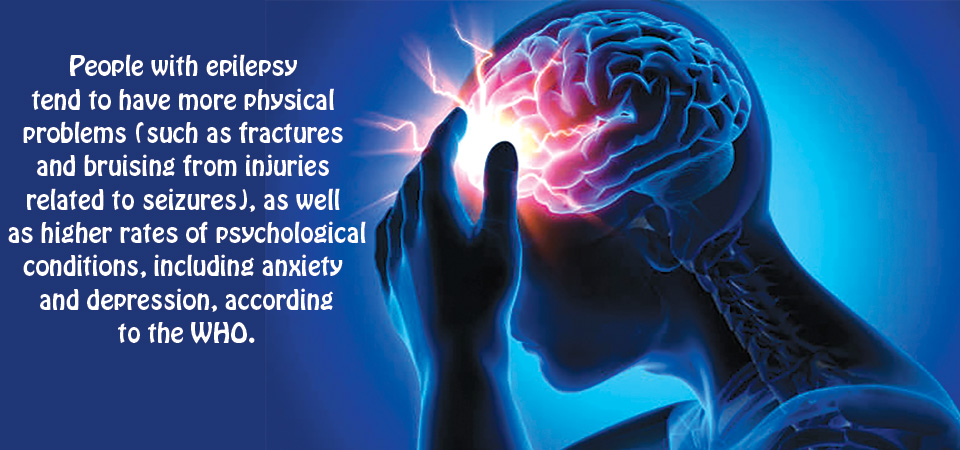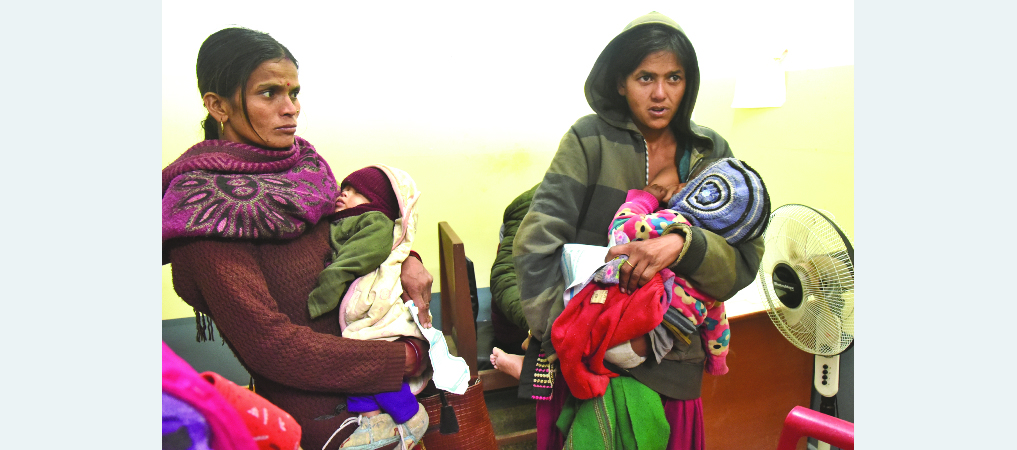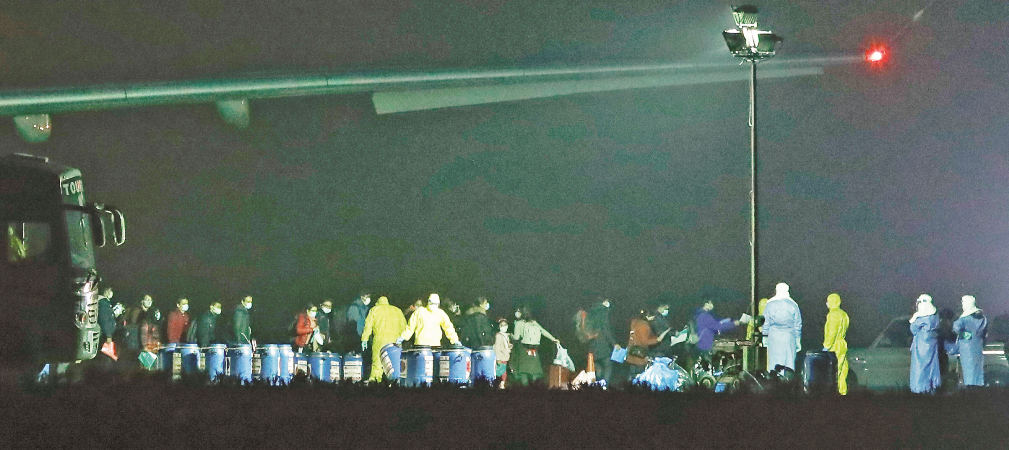Epilepsy Reducing Treatment Gap Essential

Epilepsy in Nepal is a big health issue due to the high treatment gap with the widespread use of traditional healers. The treatment gap is found due to poor understanding of epilepsy among patients and poor access to health specialists.
Despite hailing from a well-educated family, Sita Sharma (name changed), a 32-year-old woman from Biratnagar, did not get proper treatment for epilepsy seizures for many years.
After Sharma had her first epileptic seizure at the age of 17, her family began to search for a cure. They tried Dhamis and Jhakris (village shamans), witchdoctors and prayers and worship to gods. The victim was again taken to many hospitals but her disease was not properly diagnosed. Visits to the India-based hospitals too went in vain.
Detection of the cause of the seizure remained very difficult. However, she received the much-needed treatment at the National Neuro Centre, which changed her life.
"If I had received the medical treatment earlier, I would not have to bear all those psychological and physical stresses," she said. Similarly, Govinda Rimal, (name changed), a 54-year-old man, had to face discrimination and was stigmatised for having epileptic seizures.
Earlier, he suffered silently and alone for more than seven years. Rimal was left untreated due to stigma and shame. After receiving treatment from Bir hospital, he is leading his normal life. "I had no idea what I was going through, I was reluctant to visit the nearby health care facilities due to hesitation," said Rimal.
These are only examples of patients with epilepsy who are not getting treatment on time due to certain factors. Such a situation of patient demands greater efforts in patient education and awareness for the treatment of epilepsy.
According to doctors, epilepsy is a neurological disorder in which the patient suffers from abnormal electrical activity, causing seizures and loss of consciousness.
Factors for ETG
The majority of people with epilepsy are treated inadequately and inappropriately because of ignorance, stigma and limited health resources. "The Epilepsy Treatment Gap (ETG) is caused as many people with active epilepsy are not being appropriately treated either due to lack of access to treatment or inadequate treatment and are left without being properly diagnosed," said Dr Suman Bhattarai, a consultant neurologist.
This treatment gap is a major cause of suffering and death leading to the socioeconomic and emotional burden of the disease. Due to the traditional practice, the treatment gap may have exceeded 70 per cent in Nepal, according to doctors.
Due to the deeply rooted, traditional beliefs, people are deprived of getting proper treatment for the disease. Even today, in rural parts of the country, epilepsy is considered as having supernatural causes, patients visit traditional healers rather than physicians, and may never receive treatment and medicines.
Stigma influences the treatment gap, people with epilepsy are isolated and even abused Many families of patients with epilepsy follow traditional ways of healing such as worshipping family deities, wearing amulets (butis, jantar, beets) engaging in animal sacrifice, worshipping dead ancestors (pitri puja), shamanism (Jhar phuk) worshipping spirits and ghosts, and evil spirits by shamans (dhami jhankris), forcing patients to smell dirty clothes and shoes, and beating them with broomsticks and hot irons.
The majority of people with epilepsy in the world are from low or middle-income countries. The treatment gaps in these countries range from 50 to 90 per cent and mainly in rural areas than in cities.
Causes And Symptoms
According to neurologists, epilepsy is caused by traumatic brain injuries, prenatal traumas, strokes and central nervous system infections caused by neurocysticercosis, a preventable condition caused by swine tapeworm larval cysts.
"The parasitic infection, which is preventable, causes 47 per cent of epilepsy cases in Nepal. Many patients with such illnesses are still underdiagnosed due to the lack of proper understanding about the disease."
As per the WHO, temporary symptoms include loss of awareness or consciousness, disturbances in movement, sensation (including vision, hearing and taste), mood, and other cognitive functions.
People with epilepsy tend to have more physical problems (such as fractures and bruising from injuries related to seizures), as well as higher rates of psychological conditions, including anxiety and depression, according to the WHO.
"The risk of premature death in people with epilepsy is up to three times higher than in the general population, with the highest rates of premature mortality found in low- and middle-income countries and rural areas."
Early diagnosis important
Patients with epilepsy must be diagnosed accurately and quickly. "If not treated in the early stages, patients will be at risk of poorly controlled seizures which will obstruct their regular activities," said Lekhjung Thapa, a senior consultant neurologist. Most epilepsy patients never consult with a specialist, which is why sometimes treatment is inadequate.
According to the WHO, up to 70 per cent of people living with epilepsy could become seizure-free with the appropriate use of anti-seizure medicines.
Epilepsy is curable and one can lead a normal life, according to health experts. Epilepsy occurs when one has a seizure. It is not a lifelong disease and in most cases, it is cured completely.
"Almost two-thirds of epilepsy patients can be cured with medications and another one --third of the patient's condition would be known through MRI, CT-Scan and video EEG investigations, said Dr Thapa.
Epilepsy emerges from uncontrolled current flow from the brain. Electrical activity always happens in our brain. People get a seizure when there is a sudden burst of electrical voltage in the brain, explained Dr Thapa.
Epilepsy Cases Increasing
Epilepsy is included in the annual health reporting system by the government, which shows that the number of cases is increasing. According to the data of the Health Management Information System, under the Department of Health Services of the Ministry of Health and Population, 24,532 cases of epilepsy were detected in the fiscal year 2021/22. Pushpa Shrestha, data officer at the DoH, informed that 15,647 cases of epilepsy were detected in the fiscal year 2016/17.
According to Shrestha, the prevalence of epilepsy is high in Bagmati Province. The data shows that 10,834 cases of epilepsy were detected in Bagmati in the fiscal year 2021/22.
After Bagmati, Lumbini Province recorded the second-highest cases of epilepsy with 3,747 cases. In Province 1, 3,585 cases were detected, in Gandaki, 2,550, in Madhesh 2,017 cases, 1,149 cases in Sudhurpachim and 650 in Karnali province.
Similarly, the prevalence of epilepsy was high in Bagmati province with 7,301 cases in the fiscal year 2016/17. Similarly, 1,632 cases were detected in Province 1, were in Madhesh Province 310 cases were detected, 2,424 in Gandaki, 2,859 in Lumbini, 366 in Karnali and 755 in Sudhurpachim.
According to doctors, cases of epilepsy are increasing with the interventions of disease and access to health care facilities.
Treatment facilities
The government is providing free regular medicines to epilepsy patients. Free medicines are being provided from all the government health facilities.
According to Dr Rajib Jha, consultant neurosurgeon at Bir Hospital, around 15 cases of epilepsy are being detected daily at the hospital.
Most referral patients visit the hospital from various places across the nation, said Dr Jha. "Many patients are found practising with traditional healers before visiting health facilities," said Dr Jha.
"The number is increasing as awareness about the disease is also increasing, said Dr Jha. According to Dr Jha, 70 per cent of patients with epilepsy can be cured if the disease is diagnosed on time. It can be prevented by regular medication for two to five years or by some surgeries, added Dr Jha. There are no separate hospital beds designated for epilepsy in government hospitals. Patients are admitted to either the neurology ward or the general medical ward.
As diagnostic procedures, EEG, MRI and CT scans are available at the hospitals. The government hospital also provides sub-specialised epilepsy services including neuropsychological services, therapeutic drug monitoring, psychiatric counselling, social rehabilitation and special education.
Prevalence
According to Dr Suman Bhattarai, senior neurologist and deputy director at the National Neuro Centre, the prevalence of epilepsy was 7.3 per 1,000 populations in Nepal. Epilepsy can start at any age.
Epilepsy can be caused due to lack of oxygen during birth or is caused by a stroke, brain tumour, severe head injury, or brain infection, according to Dr Bhattarai.
"The cause of epilepsy was found among 50 per cent infected people and another 50 per cent did not have any cause," said Bhattarai. Epilepsy can be seen among those with low sugar levels, salt and calcium in the body, said Dr Bhattarai. Epilepsy is a common condition that affects the brain and causes frequent seizures.
Seizures are bursts of electrical activity in the brain that temporarily affect the part of the brain. Due to which people show different activities and loss of consciousness, he added.
Essential Things To Do
To reduce the epilepsy treatment gap, massive awareness and campaign among the public and access to health care are very essential, according to doctors.
Due to the lack of an effective health care system, the diagnostic gap and the therapeutic gap is still prevalent in Nepal. Epilepsy also affects cognitive, physical, and social aspects of the individual who needs more care from society, especially in areas where there lacks access to treatment, said Dr Jha. "Greater awareness of epilepsy and effectiveness of treatment would reduce the gap," said Dr Jha.
Proper diagnosis and treatment for epilepsy must be integrated into basic health facilities, suggested doctors.
"We need to sensitise the concerned authorities to ensure regular availability of medicines at health facilities and aware people by dispelling misconceptions and early detection of epilepsy."
Basic health service providers should be trained for the diagnosis and management of early epilepsy, added Dr Jha.
According to doctors, the concerned authorities should mobilise trained locals such as Epilepsy Field Workers (EFW), who can increase awareness within a community. EFW would help eliminate stigmatisation regarding the disease. By raising awareness, identification, diagnosis of the disease from various communities, the EFW would help identify the prevalence of the disease. They could also help in delivering treatment services with the help of a specialist.
Purple Day
The National Neuro centre in association with Epilepsy Foundation Nepal is creating an Epilepsy awareness programme by lightening Dharahara purple on 26th March, on the occasion of Purple Day, a global initiative dedicated to raising epilepsy awareness, dispelling myths and increasing support to those affected.
The day is celebrated to increase the public's knowledge of neurological conditions affecting nearly 50 million people worldwide. It is estimated that up to 70 per cent of people living with epilepsy could live seizure-free if properly diagnosed and treated. The risk of premature death in people with epilepsy is up to three times higher than in the general population.
To support epilepsy awareness people are encouraged to wear purple. People are encouraged to join the purple day movement and learn more about epilepsy. By observing the day, if people know someone has epilepsy, speak up and help eliminate the stigma associated with epilepsy.
(A journalist at TRN, Rijal writes about health issues)
Recent News

Do not make expressions casting dout on election: EC
14 Apr, 2022
CM Bhatta says may New Year 2079 BS inspire positive thinking
14 Apr, 2022
Three new cases, 44 recoveries in 24 hours
14 Apr, 2022
689 climbers of 84 teams so far acquire permits for climbing various peaks this spring season
14 Apr, 2022
How the rising cost of living crisis is impacting Nepal
14 Apr, 2022
US military confirms an interstellar meteor collided with Earth
14 Apr, 2022
Valneva Covid vaccine approved for use in UK
14 Apr, 2022
Chair Prachanda highlights need of unity among Maoist, Communist forces
14 Apr, 2022
Ranbir Kapoor and Alia Bhatt: Bollywood toasts star couple on wedding
14 Apr, 2022
President Bhandari confers decorations (Photo Feature)
14 Apr, 2022








